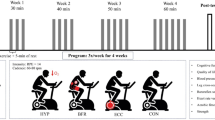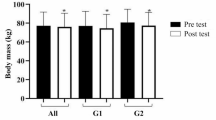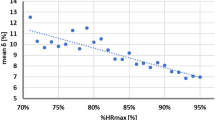Abstract
Study design: Energy expenditure (EE) and fat oxidation in handbike cycling compared to cycling in order to determine the intensity that elicits maximal fat oxidation in handbike cycling.
Objective: To establish the exercise intensity with the highest fat oxidation rate in handbike cycling compared with cycling (control group) in order to give training recommendations for spinal cord-injured (SCI) athletes performing handbike cycling.
Setting: Institute of Sports Medicine, Swiss Paraplegic Centre, Nottwil, Switzerland.
Methods: Eight endurance-trained handbike cyclists (VO2 peakhandbike cycling 37.5±7.8 ml/kg/min) and eight endurance trained cyclists (VO2 peakcycling 62.5±4.5 ml/kg/min) performed three 20-min exercise blocks at 55, 65 and 75% VO2 peak in handbike cycling on a treadmill or in cycling on a cycling ergometer, respectively, in order to find the intensity with the absolutely highest fat oxidation.
Results: The contribution of fat to total EE was highest (39.1±16.3% EE) at 55% VO2 peak in handbike cycling compared to cycling, where highest contribution of fat to EE (50.8±13.8%) was found at 75% VO2 peak. In handbike cycling, the highest absolute fat oxidation (0.28±0.10 g/min) was found at 55% VO2 peak compared to cycling, where highest fat oxidation (0.67±0.20 g/min) was found at 75% VO2 peak.
Conclusion: Well-trained handbike cyclists have their highest fat oxidation at 55% VO2 peakhandbike cycling compared to well-trained cyclists at 75% VO2 peakcycling. Handbike cyclists should perform endurance exercise training at 55% VO2 peakhandbike cycling, whereas well-trained cyclists should be able to exercise at 75% VO2 peakcycling. For training recommendations, the heart rate at 55% VO2 peakhandbike cycling lies at 135±6 bpm in handbike cycling in SCI compared to 147±14 bpm at 75% VO2 peakcycling in well-trained cyclists. We presume that the reduced muscle mass involved in exercise during handbike cycling is the most important factor for impaired fat oxidation compared to cycling. But also other factors as fitness level and haemodynamic differences should be considered. Our results are only applicable to well-trained handbike cyclists with SCI and not for the general SCI population.
Similar content being viewed by others
Log in or create a free account to read this content
Gain free access to this article, as well as selected content from this journal and more on nature.com
or
References
Baumann WA et al. Risk factors for atherogenesis and cardiovascular autonomic function in persons with spinal cord injury. Spinal Cord 1999; 37: 601–616.
Hoffman MD . Cardiorespiratory fitness and training in quadriplegics and paraplegics. Sports Med 1986; 3: 312–330.
Romijn JA et al. Regulation of endogenous fat and carbohydrate metabolism in relation to exercise intensity and duration. Am J Physiol 1993; 265: E380–E391.
Romijn JA et al. Substrate metabolism during different exercise intensities in endurance-trained women. J Appl Physiol 2000; 88: 1707–1714.
Achten J, Gleeson M, Jeukendrup AE . Determination of the exercise intensity that elicits maximal fat oxidation. Med Sci Sports Exerc 2002; 34: 92–97.
Astorino TA . Is the ventilatory threshold coincident with maximal fat oxidation during submaximal exercise in women? J Sports Med Phys Fitness 2000; 40: 209–216.
Van Loon LJC et al. The effects of increasing exercise intensity on muscle fuel utilisation in humans. J Physiol 2001; 536: 295–304.
Knechtle B et al. Fat oxidation at different intensities in wheelchair racing. Spinal Cord 2004; 42: 24–28.
Knechtle B et al. Comparison of fat oxidation in arm cranking in spinal cord-injured people versus ergometry in cyclists. Eur J Appl Physiol 2003; 90: 614–619.
Steinacker JM, Liu Y, Reissnecker S . Abbruchkriterien bei der Ergometrie. Dtsch Z Sportmed 2002; 53: 228–229.
Wassermann K et al. Anaerobic threshold and respiratory gas exchange during exercise. J Appl Physiol 1973; 35: 236–243.
Frayn KN . Calculation of substrate oxidation rates in vivo from gaseous exchange. J Appl Physiol 1983; 55: 628–634.
Atwater WO . Coefficients of digestibility and availability of the nutrients of food. Proc Am Physiol Soc 1909; 30: 14–19.
Weyand PG et al. Peak oxygen deficit during one- and two-legged cycling in men and women. Med Sci Sports Exerc 1993; 25: 584–591.
Bond V et al. Aerobic capacity during two-arm and one-leg ergometric exercise. Int Rehabil Med 1986; 8: 79–81.
Vint A et al. Aerobic metabolism and cardioventilatory responses in paraplegic athletes during an incremental wheelchair exercise. Eur J Appl Physiol 1997; 76: 455–461.
Hopman MT et al. Limits to maximal performance in individuals with spinal cord injury. Int J Sports Med 1998; 19: 98–103.
Edwards BG, Marsolais EB . Metabolic responses to arm ergometry and functional neuromuscular stimulation. J Rehabil Res Dev 1990; 27: 107–113.
Coutts KD, Rhodes EC, McKenzie DC . Maximal exercise response of tetraplegics and paraplegics. J Appl Physiol 1983; 55: 479–482.
Van Loan MD et al. Comparison of physiological responses to maximal arm exercise among able-bodied, paraplegics and quadriplegics. Paraplegia 1987; 25: 397–405.
Chow JW et al. Biomechanical comparison of two racing wheelchair propulsion techniques. Med Sci Sports Exerc 2001; 33: 476–484.
Hintzy F, Tordi N, Perrey S . Muscular efficiency during arm cranking and wheelchair exercise: a comparison. Int J Sports Med 2002; 23: 408–414.
Yasuda N, Ruby BC, Gaskill SE . Substrate utilization during arm and leg exercise relative to the ventilatory threshold in men. J Sports Med Phys Fitness 2002; 42: 403–408.
Bassett DR, Howley ET . Limiting factors for maximum oxygen uptake and determinants of endurance performance. Med Sci Sports Exerc 2000; 33: 70–84.
Sjödin B, Svedenhag J . Applied physiology of marathon running. Sports Med 1985; 2: 83–99.
Brunner C, Michel D . Leistungsphysiologie und leistungslimitierende Faktoren im Rollstuhlsport. Schweiz Z Sportmed Sporttrauma 1996; 44: 13–17.
Gass GC, Camp EM . Physiological characteristics of trained Australian paraplegic and tetraplegic subjects. Med Sci Sports Exerc 1979; 11: 256–259.
Gass GC et al. The effects of prolonged exercise on spinally injured subjects. Med Sci Sports Exerc 1981; 13: 277–283.
Fisher AG et al. Noninvasive evaluation of world class athletes engaged in different modes of training. Am J Cardiol 1989; 63: 337–341.
Neumann G . Sportartengruppenspezifische Leistungsfähigkeit. In: Dirix A, Knuttgen HG, Tittel K (eds). Olympia Buch der Sportmedizin, Deutscher Ärzte-Verlag: Köln 1988.
Coyle EF . Substrate utilization during exercise in active people. Am J Clin Nutr 1995; 61: S968–S979.
Pirnay F et al. Exogenous glucose oxidation during exercise in relation to the power output. Int J Sports Med 1995; 16: 456–460.
Brechtel K et al. Utilisation of intramyocellular lipids (IMCLs) during exercise as assessed by proton magnetic resonance spectroscopy (1H-MRS). Horm Metab Res 2001; 33: 63–66.
Stepto NK et al. Metabolic demands of intense aerobic interval training in competitive cyclists. Med Sci Sports Exerc 2001; 33: 303–310.
Kanaley JA et al. Fatty acid kinetic responses to running above or below lactate threshold. J Appl Physiol 1995; 79: 439–447.
Sidossis LS et al. Regulation of plasma fatty acid oxidation during low- and high-intensity exercise. Am J Physiol 1997; 272: E1065–E1070.
Christmass MA et al. Brief intense exercise followed by passive recovery modifies the pattern of fuel use in humans during subsequent sustained intermittent exercise. Acta Physiol Scand 2001; 172: 39–52.
Costill DL . Metabolic responses during distance running. J Appl Physiol 1970; 28: 251–255.
Stegman H, Kindermann W, Schabel A . Lactate kinetics and individual anaerobic threshold. Int J Sports Med 1981; 2: 160–165.
Aminoff T et al. Prediction of acceptable physical work loads based on responses to prolonged arm and leg exercise. Ergonomics 1998; 41: 109–120.
Trudeau F et al. Lack of antilipolytic effect of lactate in subcutaneous abdominal adipose tissue during exercise. J Appl Physiol 1999; 86: 1800–1804.
Kindermann W, Simon G, Keul J . The significance of the aerobic–anaerobic transition for determination of workload intensities during endurance training. Eur J Appl Physiol 1979; 42: 25–34.
Ribeiro JP et al. Heart rate break point may coincide with the anaerobic and not the aerobic threshold. Int J Sports Med 1985; 6: 220–224.
Rowland T, Lisowski R . Hemodynamic responses to increasing cycle cadence in 11-year old boys: role of the skeletal muscle pump. Int J Sports Med 2001; 22: 405–409.
Brisswalter J et al. Energetically optimal cadence vs. freely chosen cadence during cycling: effect of exercise duration. Int J Sports Med 2000; 21: 60–64.
Hintzy F et al. Optimal pedalling velocity characteristics during maximal and submaximal cycling in humans. Eur J Appl Physiol 1999; 79: 426–432.
Horowitz JF, Sidossis LS, Coyle EF . High efficiency of type I muscle fibers improves performance. Int J Sports Med 1994; 15: 152–157.
Flynn MG et al. Muscle fiber composition and respiratory capacity in triathletes. Int J Sports Med 1987; 8: 383–386.
Schantz P et al. Skeletal muscle of trained and untrained paraplegics and tetraplegics. Acta Physiol Scand 1997; 161: 31–39.
Koppo K, Bouckaert J, Jones AM . Oxygen uptake kinetics during high-intensity arm and leg exercise. Respir Physiol Neurobiol 2002; 133: 241–250.
Schneider DA, Wing AN, Morris NR . Oxygen uptake and heart rate kinetics during heavy exercise: a comparison between arm cranking and leg cycling. Eur J Appl Physiol 2002; 88: 100–106.
Hultman E . Fuel selection, muscle fibre. Proc Nutr Soc 1995; 54: 107–121.
Hopman MT et al. Blood redistribution and circulatory responses to submaximal arm exercise with spinal cord injury. Scand J Rehabil Med 1998; 30: 167–174.
Faria EW, Faria IE . Cardiorespiratory responses to exercises of equal relative intensity distributed between the upper and lower body. J Sports Sci 1998; 16: 309–315.
Toner MM, Glickman EL, McArdle WD . Cardiovascular adjustments to exercise distributed between the upper and lower body. Med Sci Sports Exerc 1990; 22: 773–778.
Toner MM et al. Cardiorespiratory responses to exercise distributed between the upper and lower body. J Appl Physiol 1983; 54: 1403–1407.
Author information
Authors and Affiliations
Rights and permissions
About this article
Cite this article
Knechtle, B., Müller, G. & Knecht, H. Optimal exercise intensities for fat metabolism in handbike cycling and cycling. Spinal Cord 42, 564–572 (2004). https://doi.org/10.1038/sj.sc.3101612
Published:
Issue date:
DOI: https://doi.org/10.1038/sj.sc.3101612
Keywords
This article is cited by
-
The aerobic performance of trained and untrained handcyclists with spinal cord injury
European Journal of Applied Physiology (2012)



